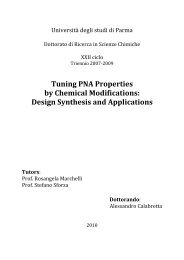Create successful ePaper yourself
Turn your PDF publications into a flip-book with our unique Google optimized e-Paper software.
488 Int Arch Occup Environ Health (2008) 81:487–493<br />
higher pulmonary tissue Cr levels than controls (Tsuneta<br />
et al. 1980), whereas Cr levels in occupationally unexposed<br />
lung cancer patients and patients with other lung diseases<br />
are lower and variable.<br />
Exhaled breath condensate (EBC), which is obtained by<br />
cooling the air exhaled under conditions of spontaneous<br />
breathing, has recently been proposed as a promising biological<br />
Xuid to monitor lung pathobiology. Various biomarkers<br />
of inXammation and oxidative stress have been<br />
identiWed and assayed (Rahman and Kelly 2003; Horvath<br />
et al. 2005) and, over the last year, it has been demonstrated<br />
that traces of pneumotoxic transition elements from<br />
tobacco smoke or polluted environments, or involved in<br />
oxidative stress as part of the redox system, can be found in<br />
EBC (Mutti et al. 2006). Furthermore, a number of transition<br />
metals have been measured in pulmonary tissue<br />
(Adachi et al. 1991; Gerhardsson and Nordberg 1993;<br />
Kubala-Kukus et al. 1999), and Cr has been related to biomarkers<br />
of oxidative stress in the EBC of exposed chrome<br />
plating workers (Caglieri et al. 2006). These Wndings suggest<br />
that the measurement of EBC Cr seems to be a promising<br />
method for deWning target organ Cr levels without<br />
using invasive means.<br />
The aim of this study was to measure Cr in EBC and in<br />
urine in non-occupationally exposed non-small cell lung<br />
cancer (NSCLC) patients before and after surgical intervention.<br />
Moreover, we also took the advantage of this opportunity<br />
to investigate the correlation between Cr levels in EBC<br />
and pulmonary tissue.<br />
Materials and methods<br />
Subjects<br />
We enrolled 20 patients, who underwent tumour resection<br />
because of histological evidence of NSCLC at the University<br />
of Parma’s Department of Thoracic Surgery. Tumour<br />
size and node involvement were assessed using the International<br />
Union Against Cancer TNM staging system, and all<br />
of the patients were classiWed as having stage Ia, Ib or IIa<br />
lung cancer. None of the patients received radiation or chemotherapy<br />
before surgery. In particular, stage I (a or b) is<br />
characterised by the absence of regional lymph node metastasis<br />
(N0) and distant metastasis (M0) and stage IIa<br />
(N1M0) is characterised by the presence of ipsilateral peribronchial<br />
and/or ipsilateral hilar nodal metastases or intrapulmonary<br />
nodes involved by direct extension of the<br />
primary tumour, and by the absence of distant metastasis.<br />
The asymptomatic group of control were 20 non-smokers,<br />
not occupationally exposed to Cr, without any pulmonary<br />
symptoms or a history of pulmonary disease, and with<br />
normal lung spirometry results.<br />
123<br />
Table 1 shows the characteristics of the study subjects.<br />
In particular, 19 of the 20 NSCLC patients were smokers or<br />
ex-smokers, all of whom had a history of at least 20 years<br />
smoking of at least 15 cigarettes/day.<br />
Study design<br />
Before enrolment, the subjects completed a short questionnaire<br />
concerning their current and previous medical history.<br />
The EBC and urine samples of the NSCLC patients were<br />
assessed immediately before and 2–4 days after tumour<br />
resection, when patients were able to perform the manoeuvre.<br />
Urine samples were obtained from only 15 patients, as<br />
the other Wve presented with haematuria. Portions of cancerous<br />
and non-cancerous lung tissue pieces were collected<br />
during surgery, and immediately stored at ¡80°C until<br />
analysis. The control EBC and urine samples were collected<br />
during a normal working day in our laboratory.<br />
All of the subjects gave their written informed consent to<br />
the procedures, which were approved by our local ethics<br />
committee. The biological material was sampled as laid<br />
down in the Declaration of Helsinki.<br />
EBC collection<br />
EBC was collected using a TURBO-DECCS condenser<br />
(Italchill, Parma, Italy) as previously described (Caglieri<br />
et al. 2006; Goldoni et al. 2005, Mutti et al. 2006); the<br />
selected condensation temperature was ¡5°C.<br />
The subjects were asked to breathe tidally through the<br />
mouthpiece for 10 min. They were instructed to form a complete<br />
seal around the mouthpiece with their mouth, which<br />
had to be kept dry by periodically swallowing excess saliva.<br />
They were also asked to rinse their mouth with drinking<br />
water thoroughly before, and every 5 min during the test. The<br />
NSCLC patients had no diYculty in performing the manoeuvre<br />
even during 2–4 days after tumour resection.<br />
The EBC volume was measured using a calibrated<br />
pipette, with salivary contamination being excluded by<br />
Table 1 Demographic characteristics of studied groups<br />
NSCLC Controls<br />
Subjects (no.) 20 20<br />
Age (median, years) 68.5 62.5<br />
Sex (male/female) 17/3 14/6<br />
Current smokers 10 0<br />
Ex-smokers 9 0<br />
Never smokers 1 20<br />
The ex-smokers had stopped smoking for at least 1 year; otherwise<br />
they were considered to be current smokers. All of the ex-smokers had<br />
a 20–50-year history of smoking at least 15 cigarettes/day, like the current<br />
smokers
















